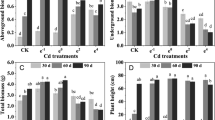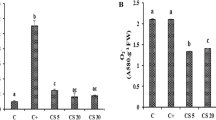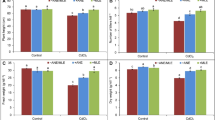Abstract
Polygonatum cyrtonema Hua (PC) and Bletilla striata (BS) are widely used and planted as tuber traditional Chinese medicinal materials (TCMMs). Cadmium (Cd) is one of the major causes of soil pollution and challenge to the quality and safety of TCMMs. Understanding the absorption and distribution of Cd is important for addressing the risks posed by its residues. As a result, the higher Cd translocation factor (TF) results in the lower Cd bioconcentration factor (BCF) in the PC tuber than that of BS attributed to a lower Cd concentration in the PC tuber, which guaranteed its safe utilization and edible safety under 1 mg·kg−1 Cd soil. Cd stress overall activated peroxidase (POD), catalase (CAT), and water-extractable polysaccharides in PC (PCP1) to exhibit better antioxidation, while the superoxide dismutase (SOD) in BS increased by approximately 206–277% to alleviate more severe oxidative damage. Particularly, Cd induced an increase in PCP1 higher than that of water-extractable polysaccharides of BS (BSP1) by approximately 335% to 1351%. PC exhibited effective strategies for alleviating Cd toxicity, including transferring Cd to nonmedicinal parts, increasing polysaccharides, and synergistically activating the enzymatic antioxidant system. This study expands the application for the safe utilization of low-Cd contaminated soil and provides novel insights for tuber TCMMs to alleviate Cd toxicity.
Graphical abstract







Similar content being viewed by others
References
Amamou S, Lazreg H, Hafsa J, Majdoub H, Rihouey C, Le Cerf D, Achour L (2020) Effect of extraction condition on the antioxidant, antiglycation and α-amylase inhibitory activities of Opuntia macrorhiza fruit peels polysaccharides. LWT. 127:109411. https://doi.org/10.1016/j.lwt.2020.109411
Belkadhi A, Djebali W, Hediji H, Chaibi W (2016) Cellular and signaling mechanisms supporting cadmium tolerance in salicylic acid treated seedlings. Plant Sci Today. 3:41–47. https://doi.org/10.14719/pst.2016.3.1.180
Boussen S, Soubrand M, Bril H, Ouerfelli K, Abdeljaouad S (2013) Transfer of lead, zinc and cadmium from mine tailings to wheat (Triticum aestivum) in carbonated Mediterranean (Northern Tunisia) soils. Geoderma. 192:227–236. https://doi.org/10.1016/j.geoderma.2012.08.029
Chaitanya KSK, Naithani SC (1994) Role of superoxide, lipid-peroxidation and superoxide-dismutase in membrane perturbation during loss of viability in seeds of Shorea-Robusta Gaertn F. New Phytologist. 126:623–627. https://doi.org/10.1111/j.1469-8137.1994.tb02957.x
Chen D, Chen D, Xue R, Long J, Lin X, Lin Y, Jia L, Zeng R, Song Y (2019) Effects of boron, silicon and their interactions on cadmium accumulation and toxicity in rice plants. J Hazard Mater. 367:447–455. https://doi.org/10.1016/j.jhazmat.2018.12.111
Chen S, Lin R, Lu H, Wang Q, Yang J, Liu J, Yan C (2020a) Effects of phenolic acids on free radical scavenging and heavy metal bioavailability in kandelia obovata under cadmium and zinc stress. Chemosphere. 249:126341. https://doi.org/10.1016/j.chemosphere.2020.126341
Chen Y, Zou J, Sun H, Qin J, Yang J (2020b) Metals in Traditional Chinese medicinal materials (TCMM): a systematic review. Ecotoxicol Environ Safety. 207:111311–111311. https://doi.org/10.1016/j.ecoenv.2020.111311
Commission CP (2020) Pharmacopoeia of the people’s Republic of China. China Medical Science Press, Beijing
Du B, Zhou J, Lu B, Zhang C, Li D, Zhou J, Jiao S, Zhao K, Zhang H (2020) Environmental and human health risks from cadmium exposure near an active lead-zinc mine and a copper smelter, China. Sci Total Environ. 720:137585. https://doi.org/10.1016/j.scitotenv.2020.137585
Dunbar KR, McLaughlin MJ, Reid RJ (2003) The uptake and partitioning of cadmium in two cultivars of potato (Solanum tuberosum L.). J Exp Botany. 54:349–354. https://doi.org/10.1093/jxb/erg016
Dunnill C, Patton T, Brennan J, Barrett J, Dryden M, Cooke J, Leaper D, Georgopoulos NT (2017) Reactive oxygen species (ROS) and wound healing: the functional role of ROS and emerging ROS-modulating technologies for augmentation of the healing process. Intl Wound J. 14:89–96. https://doi.org/10.1111/iwj.12557
Gill SS, Hasanuzzaman M, Nahar K, Macovei A, Tuteja N (2013) Importance of nitric oxide in cadmium stress tolerance in crop plants. Plant Physiol Biochem. 63:254–261. https://doi.org/10.1016/j.plaphy.2012.12.001
Guo J, Qin S, Rengel Z, Gao W, Nie Z, Liu H, Li C, Zhao P (2019) Cadmium stress increases antioxidant enzyme activities and decreases endogenous hormone concentrations more in Cd-tolerant than Cd-sensitive wheat varieties. Ecotoxicol Environ Safety. 172:380–387. https://doi.org/10.1016/j.ecoenv.2019.01.069
He X, Wang X, Fang J, Zhao Z, Huang L, Guo H, Zheng X (2017) Bletilla striata: medicinal uses, phytochemistry and pharmacological activities. J Ethnopharmacol. 195:20–38. https://doi.org/10.1016/j.jep.2016.11.026
Hussain A, Ali S, Rizwan M, Rehman MZ, Javed MR, Imran M, Chatha SAS, Nazir R (2018) Zinc oxide nanoparticles alter the wheat physiological response and reduce the cadmium uptake by plants. Environ Pollut. 242:1518–1526. https://doi.org/10.1016/j.envpol.2018.08.036
Kapoor D, Singh S, Kumar V, Romero R, Prasad R, Singh J (2019) Antioxidant enzymes regulation in plants in reference to reactive oxygen species (ROS) and reactive nitrogen species (RNS). Plant Gene. 19:100182. https://doi.org/10.1016/j.plgene.2019.100182
Kemper FH (2011) Handbook of Chinese medicinal plants. Phytomedicine. 18:1291. https://doi.org/10.1016/j.phymed.2011.08.062
Khan I, Iqbal M, Ashraf MY, Ashraf MA, Ali S (2016) Organic chelants-mediated enhanced lead (Pb) uptake and accumulation is associated with higher activity of enzymatic antioxidants in spinach (Spinacea oleracea L.). J Hazard Mater. 317:352–361. https://doi.org/10.1016/j.jhazmat.2016.06.007
Kilic MY, Abdelraheem WH, He X, Kestioglu K, Dionysiou DD (2019) Photochemical treatment of tyrosol, a model phenolic compound present in olive mill wastewater, by hydroxyl and sulfate radical-based advanced oxidation processes (AOPs). J Hazard Mater. 367:734–742. https://doi.org/10.1016/j.jhazmat.2018.06.062
Kraus T, Fletcher R (1994) Paclobutrazol protects wheat seedlings from heat and paraquat injury. Is detoxification of active oxygen involved? Plant Cell Physiol. 35:45–52. https://doi.org/10.1093/oxfordjournals.pcp.a078569
Li DM, Nie YX, Zhang J, Yin JS, Li Q, Wang XJ, Bai JG (2013) Ferulic acid pretreatment enhances dehydration-stress tolerance of cucumber seedlings. Biologia Plantarum. 57:711–717. https://doi.org/10.1007/s10535-013-0326-0
Liao Z, Zeng R, Hu L, Maffucci KG, Qu Y (2019) Polysaccharides from tubers of Bletilla striata: physicochemical characterization, formulation of buccoadhesive wafers and preliminary study on treating oral ulcer. Intl J Biol Macromol. 122:1035–1045. https://doi.org/10.1016/j.ijbiomac.2018.09.050
Liu H, Zhou J, Li M, Hu Y, Liu X, Zhou J (2019) Study of the bioavailability of heavy metals from atmospheric deposition on It the soil-pakchoi (Brassica chinensis L.) system. J Hazard Mater. 362:9–16. https://doi.org/10.1016/j.jhazmat.2018.09.032
Liu J, Li KQ, Xu JK, Liang JS, Lu XL, Yang JC, Zhu QS (2003) Interaction of Cd and five mineral nutrients for uptake and accumulation in different rice cultivars and genotypes. Field Crops Research. 83:271–281. https://doi.org/10.1016/s0378-4290(03)00077-7
Liu S, Yang R, Tripathi DK, Li X, He W, Wu M, Ali S, Ma M, Cheng Q, Pan Y (2018) The interplay between reactive oxygen and nitrogen species contributes in the regulatory mechanism of the nitro-oxidative stress induced by cadmium in Arabidopsis. J Hazard Mater 344:1007–1024. https://doi.org/10.1016/j.jhazmat.2017.12.004
Liu Y, Zhang C, Zhao Y, Sun S, Liu Z (2017) Effects of growing seasons and genotypes on the accumulation of cadmium and mineral nutrients in rice grown in cadmium contaminated soil. Sci Total Environ. 579:1282–1288. https://doi.org/10.1016/j.scitotenv.2016.11.115
Marklund S, Marklund G (1974) Involvement of superoxide anion radical in autoxidation of pyrogallol and a convenient assay for superoxide-dismutase. Eur J Biochem. 47:469–474
Mhamdi A, Van Breusegem F (2018) Reactive oxygen species in plant development. Development. 145. https://doi.org/10.1242/dev.164376
Mittler R (2017) ROS are good. Trends Plant Sci. 22:11–19. https://doi.org/10.1016/j.tplants.2016.08.002
Mittler R, Vanderauwera S, Suzuki N, Miller G, Tognetti VB, Vandepoele K, Gollery M, Shulaev V, Van Breusegem F (2011) ROS signaling: the new wave? Trends Plant Sci. 16:300–309. https://doi.org/10.1016/j.tplants.2011.03.007
Noctor G, Mhamdi A, Chaouch S, Han Y, Neukermans J, Marquez-Garcia B, Queval G, Foyer CH (2012) Glutathione in plants: an integrated overview. Plant Cell Environ. 35:454–484. https://doi.org/10.1111/j.1365-3040.2011.02400.x
Pan D, Wang L, Chen C, Teng B, Wang C, Xu Z, Hu B, Zhou P (2012) Structure characterization of a novel neutral polysaccharide isolated from Ganoderma lucidum fruiting bodies. Food Chem. 135:1097–1103. https://doi.org/10.1016/j.foodchem.2012.05.071
Qu H, Gao X, Zhao HT, Wang ZY, Yi JJ (2019) Structural characterization and in vitro hepatoprotective activity of polysaccharide from pine nut (Pinus koraiensis Sieb. et Zucc.). Carbohydrate Polymers. 223. https://doi.org/10.1016/j.carbpol.2019.115056
Rahman SU, Qi X, Xiao Y, Ahmad MI, Shehzad M, Zain M (2020) Silicon and its application methods improve physiological traits and antioxidants in Triticum aestivum (L.) under cadmium stress. J Soil Sci Plant Nutr. 20:1110–1121. https://doi.org/10.1007/s42729-020-00197-y
Rizwan M, Ali S, Rehman MZU, Rinklebe J, Tsang DCW, Bashir A, Maqbool A, Tack FMG, Ok YS (2018) Cadmium phytoremediation potential of Brassica crop species: a review. Sci Total Environ. 631-632:1175–1191. https://doi.org/10.1016/j.scitotenv.2018.03.104
Rizwan M, Ali S, Abbas T, Zia-ur-Rehman M, Hannan F, Keller C, Al-Wabel MI, Ok YS (2016) Cadmium minimization in wheat: a critical review. Ecotoxicol Environ Safety. 130:43–53. https://doi.org/10.1016/j.ecoenv.2016.04.001
Shi M, Zhang Z, Yang Y (2013) Antioxidant and immunoregulatory activity of Ganoderma lucidum polysaccharide (GLP). Carbohydrate Polymers. 95:200–206. https://doi.org/10.1016/j.carbpol.2013.02.081
Takahashi R, Bashir K, Ishimaru Y, Nishizawa NK, Nakanishi H (2012) The role of heavy-metal ATPases, HMAs, in zinc and cadmium transport in rice. Plant Signaling & Behavior. 7:1605–1607. https://doi.org/10.4161/psb.22454
Triantaphylidès C, Havaux M (2009) Singlet oxygen in plants: production, detoxification and signaling. Trends Plant Sci. 14:219–228. https://doi.org/10.1016/j.tplants.2009.01.008
Uraguchi S, Kamiya T, Sakamoto T, Kasai K, Sato Y, Nagamura Y, Yoshida A, Kyozuka J, Ishikawa S, Fujiwara T (2011) Low-affinity cation transporter (OsLCT1) regulates cadmium transport into rice grains. Proc Natl Acad Sci USA. 108:20959–20964. https://doi.org/10.1073/pnas.1116531109
Waszczak C, Carmody M, Kangasjärvi J (2018) Reactive oxygen species in plant signaling. Ann Rev Plant Biol. 69:209–236. https://doi.org/10.1146/annurev-arplant-042817-040322
Wiart C (2013) Medicinal Plants of China, Korea, and Japan. Bioresources for tomorrow’s drugs and cosmetics. Deutsche Zeitschrift für Akupunktur. 56:56–57. https://doi.org/10.1016/j.dza.2013.06.029
Wu Y, Wang D (2008) Structural characterization and DPPH radical scavenging activity of an arabinoglucogalactan from Panax notoginseng root. J Natural Products. 71:241–245. https://doi.org/10.1021/np070323+
Xie M, Chen W, Lai X, Dai H, Sun H, Zhou X, Chen T (2019) Metabolic responses and their correlations with phytochelatins in Amaranthus hypochondriacus under cadmium stress. Environ Pollut. 252:1791–1800. https://doi.org/10.1016/j.envpol.2019.06.103
Xie MD, Chen WQ, Dai HB, Wang XQ, Yang L, Kang YC, Sun H, Wang L (2021) Cadmium-induced hormesis effect in medicinal herbs improves the efficiency of safe utilization for low cadmium-contaminated farmland soil. Ecotoxicol Environ Safety. 225:112724. https://doi.org/10.1016/j.ecoenv.2021.112724
Xu Z, Feng S, Shen S, Wang H, Yuan M, Liu J, Huang Y, Ding C (2016) The antioxidant activities effect of neutral and acidic polysaccharides from Epimedium acuminatum Franch. on Caenorhabditis elegans. Carbohydrate Polymers. 144:122–130. https://doi.org/10.1016/j.carbpol.2016.02.041
Yang H, Zhang X (2017) Polysaccharides from Polygonatum odoratum strengthen antioxidant defense system and attenuate lipid peroxidation against exhaustive exercise-induced oxidative stress in mice. Trop J Pharma Res. 16:795–801. https://doi.org/10.4314/tjpr.v16i4.8
Yu Y, Shen M, Song Q, Xie J (2018) Biological activities and pharmaceutical applications of polysaccharide from natural resources: a review. Carbohydrate Polymers. 183:91–101. https://doi.org/10.1016/j.carbpol.2017.12.009
Zhang J, Meng G, Zhai G, Yang Y, Zhao H, Jia L (2016) Extraction, characterization and antioxidant activity of polysaccharides of spent mushroom compost of Ganoderma lucidum. Intl J Biol Macromol. 82:432–439. https://doi.org/10.1016/j.ijbiomac.2015.10.016
Zhao P, Zhao C, Li X, Gao Q, Huang L, Xiao P, Gao W (2018) The genus Polygonatum: a review of ethnopharmacology, phytochemistry and pharmacology. J Ethnopharmacol. 214:274–291. https://doi.org/10.1016/j.jep.2017.12.006
Zhou J, Zhang C, Du B, Cui H, Fan X, Zhou D, Zhou J (2020) Soil and foliar applications of silicon and selenium effects on cadmium accumulation and plant growth by modulation of antioxidant system and Cd translocation: Comparison of soft vs. durum wheat varieties. J Hazardous Mater. 402:123546–123546. https://doi.org/10.1016/j.jhazmat.2020.123546
Acknowledgements
We are grateful to the workers who have helped with the transportation of experimental soils and construction of the experimental site. We thank the American Journal Experts (USA) for assistance with our English language polishing.
Availability of data and materials
All the data are available upon the request from the corresponding author.
Funding
This work was supported by the Project of Major Science and Technology of Sichuan province (grant number 2018SZDZX0028).
Author information
Authors and Affiliations
Contributions
LY and YCK contributed to the study conception and design. Data curation and analysis were performed by HBD and XQW. The first draft of the manuscript was written by LY. WQC and LY reviewed and edited the manuscript. MDX, JXL, and CG contributed to the formal analysis and software. HS, TQA, and WQC contributed to the resources and funding acquisition. All authors read and approved the final manuscript.
Corresponding author
Ethics declarations
Ethics approval
This study does not need any ethical approval.
Consent to participate
Not applicable.
Consent for publication
Not applicable.
Competing interests
The authors declare no competing interests.
Additional information
Responsible Editor: Gangrong Shi
Publisher’s note
Springer Nature remains neutral with regard to jurisdictional claims in published maps and institutional affiliations.
Highlights
• Polygonatum cyrtonema Hua (PC) is safe to utilize in low Cd-contaminated soil.
• Excellent up-transport ability contributes to reduce the accumulation of Cd in tuber.
• Appropriate Cd stress promotes the content of polysaccharides in PC.
• Polysaccharides of PC have better antioxidation than those of Bletilla striata (BS).
• Polysaccharides enhance antioxidative characters to alleviate oxidative stress.
Rights and permissions
About this article
Cite this article
Yang, L., Kang, Y., Dai, H. et al. Differential responses of polysaccharides and antioxidant enzymes in alleviating cadmium toxicity of tuber traditional Chinese medicinal materials. Environ Sci Pollut Res 29, 60832–60842 (2022). https://doi.org/10.1007/s11356-022-20136-x
Received:
Accepted:
Published:
Issue Date:
DOI: https://doi.org/10.1007/s11356-022-20136-x




